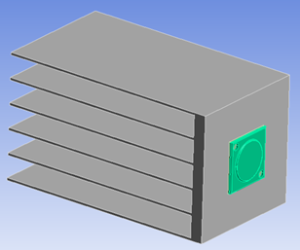...
Consider the heat sink shown in gray in the image below. It is used to dissipate the heat from an LED and a thin interface layer shown in green below. The CAD file containing the LED + Interface interface + Heat heat sink can be downloaded here.
- LED and heat sink are made of Aluminum: k=186 W/(m C)
- For the interface: k=48 W/(m C)
- Heat generated by LED: 3.3×10^7 3×107 W/m^3
This is not a step-by-step ANSYS tutorial. Rather, it states the problem to be solved and provides some tips and guidance on solving it using ANSYS Mechanical. Go through the truss and beam tutorials before attempting this problem.
Consider the plane frame structure in the figure below. All bars have cross-section properties EI = 2.5e7 N-m2 and EA = 2.5e9 N.
Find:
- The deformed shape of the frame
- The location in the frame that undergoes the maximum total deflection
- The maximum shear force and axial force in each span
- The bending moment at each span endpoint
...
- m3
- Ambient temperature: 40 C
- Convection coefficient for heat sink surfaces exposed to air: 14 W/(m2 C)
Find temperature and heat flux distribution in the model. Verify results by checking overall energy conservation and refining the mesh.
Pre-Analysis
| HTML |
|---|
<iframe width="600" height="360" src="https://www.youtube.com/embed/lZlo7hKjSlE" frameborder="0" allowfullscreen></iframe> |
Model Setup
Start Ansys Workbench by typing Workbench in the Start menu or click Workbench app if using Apps on Demand (aka Amazon Appstream).
| HTML |
|---|
<iframe width="600" height="360" src="https://www.youtube.com/embed/8brG_dSEthk" frameborder="0" allowfullscreen></iframe> |
Numerical Results
| HTML |
|---|
<iframe width="600" height="360" src="https://www.youtube.com/embed/FP9_KIBVELAGfQatPM9KY4" frameborder="0" allowfullscreen></iframe> |
...
Energy Conservation Check and Mesh Refinement
If you are using the free Ansys student product, you won't be able to get the "convergence" object covered in the video below to solve since the number of nodes exceeds the maximum allowed in this version. A workaround is to generate a second mesh using a body sizing of 0.005m and compare the maximum temperature and heat flux on this mesh and the original mesh.
| HTML |
|---|
<iframe width="600" height="360" src="https://www.youtube.com/embed/dGuoDyLa4Ik5AW4zWxH6gU" frameborder="0" allowfullscreen></iframe> |
...
Geometry Modification
| HTML |
|---|
<iframe width="600" height="360" src="https://www.youtube.com/embed/fmCc_uv9e7kpNnapxO6CAs" frameborder="0" allowfullscreen></iframe> |
...
 Sign-up for free online course on ANSYS simulations!
Sign-up for free online course on ANSYS simulations!